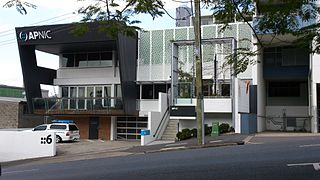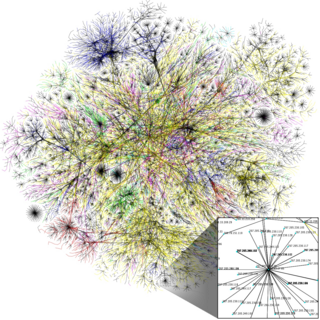The American Registry for Internet Numbers (ARIN) is the regional Internet registry for the United States, Canada, and many Caribbean and North Atlantic islands. ARIN manages the distribution of Internet number resources, including IPv4 and IPv6 address space and AS numbers. ARIN opened for business on December 22, 1997 after incorporating on April 18, 1997. ARIN is a nonprofit corporation with headquarters in Chantilly, Virginia, United States.

The Internet Corporation for Assigned Names and Numbers is a global multistakeholder group and nonprofit organization head-quartered in the United States responsible for coordinating the maintenance and procedures of several databases related to the namespaces and numerical spaces of the Internet, ensuring the Internet's stable and secure operation. ICANN performs the actual technical maintenance work of the Central Internet Address pools and DNS root zone registries pursuant to the Internet Assigned Numbers Authority (IANA) function contract. The contract regarding the IANA stewardship functions between ICANN and the National Telecommunications and Information Administration (NTIA) of the United States Department of Commerce ended on October 1, 2016, formally transitioning the functions to the global multistakeholder community.

APNIC is the regional Internet address registry (RIR) for the Asia-Pacific region. It is one of the world's five RIRs and is part of the Number Resource Organization (NRO).

The Internet Assigned Numbers Authority (IANA) is a standards organization that oversees global IP address allocation, autonomous system number allocation, root zone management in the Domain Name System (DNS), media types, and other Internet Protocol–related symbols and Internet numbers.
InterNIC, known as the Network Information Center (NIC) until 1993, was the organization primarily responsible for Domain Name System (DNS) domain name allocations and X.500 directory services. From its inception in 1972 until October 1, 1991, it was run by the Stanford Research Institute, now known as SRI International, and led by Jake Feinler. From October 1991 until September 18, 1998, it was run by Network Solutions. Thereafter, the responsibility was assumed by the Internet Corporation for Assigned Names and Numbers (ICANN).

A regional Internet registry (RIR) is an organization that manages the allocation and registration of Internet number resources within a region of the world. Internet number resources include IP addresses and autonomous system (AS) numbers.
An autonomous system (AS) is a collection of connected Internet Protocol (IP) routing prefixes under the control of one or more network operators on behalf of a single administrative entity or domain, that presents a common and clearly defined routing policy to the Internet. Each AS is assigned an autonomous system number (ASN), for use in Border Gateway Protocol (BGP) routing. Autonomous System Numbers are assigned to Local Internet Registries (LIRs) and end-user organizations by their respective Regional Internet Registries (RIRs), which in turn receive blocks of ASNs for reassignment from the Internet Assigned Numbers Authority (IANA). The IANA also maintains a registry of ASNs which are reserved for private use.

.in is the Internet country code top-level domain (ccTLD) for India. It was made available in 1989, four years after original generic top-level domains such as .com, .net and the country code like .us. It is currently administered by the National Internet Exchange of India (NIXI).
In computing, Internet geolocation is software capable of deducing the geographic position of a device connected to the Internet. For example, the device's IP address can be used to determine the country, city, or ZIP code, determining its geographical location. Other methods include examination of Wi-Fi hotspots, a MAC address, image metadata, or credit card information.

The National Internet Exchange of India (NIXI) is a non-profit company incorporated under Section 25 of the India Companies Act, 1956 with an objective of facilitating improved internet services in the country.

Internet governance consists of a system of laws, rules, policies and practices that dictate how its board members manage and oversee the affairs of any internet related-regulatory body. This article describes how the Internet was and is currently governed, some inherent controversies, and ongoing debates regarding how and why the Internet should or should not be governed in future.
A national Internet registry is an organization under the umbrella of a regional Internet registry with the task of coordinating IP address allocations and other Internet resource management functions at a national level within a country or economic unit.
WHOIS is a query and response protocol that is used for querying databases that store an Internet resource's registered users or assignees. These resources include domain names, IP address blocks and autonomous systems, but it is also used for a wider range of other information. The protocol stores and delivers database content in a human-readable format. The current iteration of the WHOIS protocol was drafted by the Internet Society, and is documented in RFC 3912.
The China Internet Network Information Center, or CNNIC, is the administrative agency responsible for domain registry affairs of .cn under the Cyberspace Administration of China.
INRegistry is the organisation responsible for the .in TLD and the native language internationalised domain name TLDs for the country. It was appointed by the government of India, and operates under the authority National Internet Exchange of India (NIXI).

IPv4 address exhaustion is the depletion of the pool of unallocated IPv4 addresses. Because the original Internet architecture had fewer than 4.3 billion addresses available, depletion has been anticipated since the late 1980s when the Internet started experiencing dramatic growth. This depletion is one of the reasons for the development and deployment of its successor protocol, IPv6. IPv4 and IPv6 coexist on the Internet.

Satyam Infoway Ltd. v. Sifynet Solutions Pvt. Ltd. was the first case to be decided by the Supreme Court of India on the issue of domain name protection, and dealt with two businesses employing variations on the same mark ("Sify") in their respective domain names.

National Knowledge Network(NKN) is a multi-gigabit national research and education network, whose purpose is to provide a unified high speed network backbone for educational and research institutions in India. The network is managed by the National Informatics Centre.
The Montevideo Statement on the Future of Internet Cooperation was released on 7 October 2013 by the leaders of a number of organizations involved in coordinating the Internet's global technical infrastructure. The statement was signed by the heads of the Internet Corporation for Assigned Names and Numbers (ICANN), the Internet Engineering Task Force, the Internet Architecture Board, the World Wide Web Consortium, the Internet Society, and the five regional Internet address registries. In large part, the statement is seen as a response to the ongoing NSA surveillance scandal. The leaders made four main points:








